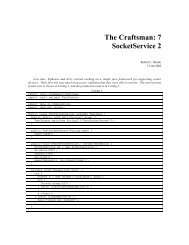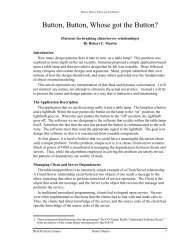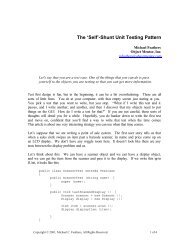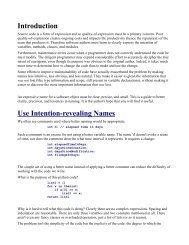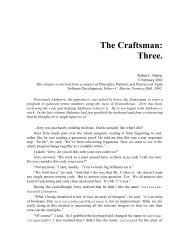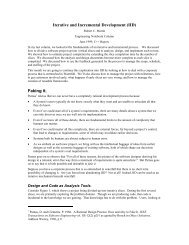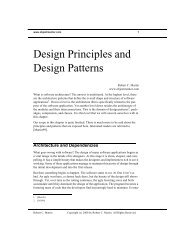Iterative and Incremental Development (IID) A ... - DePaul University
Iterative and Incremental Development (IID) A ... - DePaul University
Iterative and Incremental Development (IID) A ... - DePaul University
You also want an ePaper? Increase the reach of your titles
YUMPU automatically turns print PDFs into web optimized ePapers that Google loves.
<strong>Iterative</strong> <strong>and</strong> <strong>Incremental</strong> <strong>Development</strong> (<strong>IID</strong>)<br />
Robert C. Martin<br />
Engineering Notebook Column<br />
April, 1999, C++ Report.<br />
In my last column I took a satirical look at the waterfall process, trying to expose some of its faults. This<br />
month we are going to look at an alternative that tries to deal with those faults. But before we begin I’d<br />
like to say: Thank goodness that waterfall showed up in the early seventies! Back in those days, there was<br />
very little thought put into the structure of a software application prior to coding it. If waterfall did nothing<br />
else, it got us to accept the need to think before we code.<br />
A Summary of the Problems with Waterfall.<br />
The symptoms discussed in my last column can be attributed to the following three attributes of the<br />
waterfall model of development:<br />
1. No feedback between phases. Once Analysis is done, it is done, <strong>and</strong> everyone should be working on<br />
Design. Once Design is done, it is done, <strong>and</strong> everybody should be working on Implementation.<br />
2. Hard dates on phases. The dates set for completing Analysis <strong>and</strong> Design are major milestones that<br />
developers are measured against.<br />
3. No completion criteria for either Analysis or Design.<br />
Lets examine each point in turn.<br />
No feedback between phases.<br />
Although Dr. Winston Royce, the inventor of Waterfall, clearly showed that there must be feedback<br />
between the phases, many development managers have ignored this. Ignoring the feedback between<br />
Analysis <strong>and</strong> Design is tantamount to saying that we can analyze the entire application up front without<br />
learning anything from the structure or behavior of the resultant software.<br />
Though seductive, this seldom turns out to be true. To emphasize this point, Booch 1 quotes Gall 2 :<br />
“A complex system that works is invariably found to have evolved from a simple<br />
system that worked. . . . A complex system designed from scratch never works<br />
<strong>and</strong> cannot be patched up to make it work. You have to start over, beginning<br />
with a working simple system.”<br />
We poor humans are not capable of holding entire complex systems in our minds. To truly analyze them,<br />
we have to be able to touch them, fiddle with them, get inside them, <strong>and</strong> evolve them. Analysis that is<br />
deprived of the feedback from later phases, is nothing more than a hypothesis, an educated guess. And the<br />
more complicated the application, the more that Analysis is like building castles in the air.<br />
Hard dates on phases.<br />
Of all the horrible features of Waterfall, this causes the most pain. When managers saw that software<br />
development could be broken up into phases, their natural reaction was to track these phases by putting<br />
1 Object Oriented Analysis <strong>and</strong> Design with Applications, 2d. ed., Grady Booch, Addison Wesley, 1994, p.<br />
13<br />
2 Systemantics: How Systems Really Work <strong>and</strong> How They Fail, 2d. ed., J. Gall, The General Systemantics<br />
Press, 1986, p. 65
milestone dates on them. Though this seems reasonable from a project management point of view, it is<br />
actually one of the worst possible ways to abuse a development process.<br />
Teams do not make linear progress through analysis. They don’t start with requirement 1 <strong>and</strong> analyze it,<br />
then move to requirement 2 <strong>and</strong> analyze it. One cannot measure how much analysis has taken place by<br />
looking at how far the analysts have read through the requirements document.<br />
Analysis tends to be revolutionary. After thinking about a significant fraction of the requirements, some<br />
creative sole has an AHA! reaction, <strong>and</strong> gathers deep insight into the application. This insight may be<br />
right, or it may be wrong. If wrong, following it will lead to the next deep insight.<br />
That’s the way the creative process works. We learn more from our mistakes than from our successes. We<br />
stumble along in a partially r<strong>and</strong>om, partially directed walk from mistake to mistake until we finally get to<br />
something that looks reasonable.<br />
Putting a date on the completion of this process is ludicrous. It can neither be measured nor scheduled.<br />
Does that mean that software cannot be scheduled at all? No! We can schedule software, but not by<br />
scheduling intangibles like analysis. More on that later.<br />
No completion criteria.<br />
The real insidious thing about putting dates on the Analysis <strong>and</strong> Design phases, is that those dates are often<br />
met! This is not because sufficient work has been done to analyze or design the application. It is because<br />
the only completion criterion for the Analysis <strong>and</strong> Design phases is – the date.<br />
There is no way to tell when Analysis <strong>and</strong> Design are complete. It is always possible to continue Analysis.<br />
And Design is truly complete only when the code itself stops changing. There is no meaningful way to<br />
judge the completeness of an analysis or of a design.<br />
Thus, managers are often given good news when the Analysis <strong>and</strong> Design phases meet their dates.<br />
However, this good news is a lie. It is mis-information. And managers are basing their decisions on it.<br />
Feedback: The universal way to control.<br />
How do our bodies regulate our breathing? As CO 2 levels rise in our blood, signals are sent to our brain to<br />
increase respiration rate. Why do stars shine for billions of years with such consistency? The amount of<br />
energy expended provides just enough heat to hold up the mass of the star. How can cruise-controls keep<br />
our car running at the same speed whether we are going uphill or downhill? The cruise-control senses the<br />
speed of the car <strong>and</strong> regulates the flow of fuel to the engine to keep the speed constant. All these system,<br />
some natural, some evolved, <strong>and</strong> some man-made, use the same mechanism for maintaining control. That<br />
mechanism is feedback.<br />
To control a software project, we also need to use feedback. The only way to truly control a software<br />
project is to continuously measure its progress, compare that progress against the plan, <strong>and</strong> then adjust the<br />
development parameters to correct any deviation from the plan. Simple.<br />
Unfortunately, in practice, measurement cannot be made continuously; <strong>and</strong> there are very few development<br />
parameters we can adjust. Lets deal with each issue in turn.<br />
Approaching continuous measurement.<br />
Since we cannot measure the progress of a project continuously, we must measure it at certain milestones.<br />
The more milestones we have, the more we approximate continuous measurement, the better. However, we<br />
must be careful about what we choose to measure. If we choose something like the completion of Analysis<br />
or Design as measurements, the measurements will be meaningless.<br />
Tom Demarco 3 said of project management:<br />
3 Controlling Software Projects, Tom Demarco, Yourdon Press, 1982, p137
“Your project, the whole project, has a binary deliverable. On scheduled completion<br />
day, the project has either delivered a system that is accepted by the user, or it hasn’t.<br />
Everyone knows the result on that day.”<br />
The object of building a project model is to divide the project into component pieces,<br />
each of which has this same characteristic: Each activity must be defined by a<br />
deliverable with objective completion criteria. The deliverables are demonstrably done<br />
or not done.”<br />
So a binary deliverable is a deliverable that has one of two states: done or not-done. Clearly Analysis <strong>and</strong><br />
Design are not binary deliverables. They can never be shown to be complete. On the other h<strong>and</strong>, what<br />
better binary deliverable could we have than a piece of code that executes according to stated<br />
requirements?<br />
Vertical slices.<br />
When we begin an iterative <strong>and</strong> incremental development (<strong>IID</strong>), our first goal is to subdivide the project<br />
into binary deliverables. Those binary deliverables are defined as executing segments of the overall<br />
project.<br />
Known<br />
Start Date<br />
High Level Analysis<br />
Slice<br />
Slice<br />
Slice<br />
Slice<br />
Slice<br />
Slice<br />
Slice<br />
Slice<br />
Slice<br />
Slice<br />
Slice<br />
Slice<br />
Slice<br />
Slice<br />
Slice<br />
Slice<br />
Figure 1. Subdivision of the project into vertical slices.<br />
Known<br />
End Date<br />
Figure 1 shows a schematic of how this is done. The project begins with two known pieces of data. The<br />
start date <strong>and</strong> the end date. Indeed, the end date is usually the first datum known about any project.<br />
Market pressures frequently establish the end date long before there is a reasonable set of requirements.<br />
You can complain about this evil fact all you like, but it’s the way the real world works. We, as engineers,<br />
have to deal with it.<br />
The next ugly fact we have to deal with is that the requirements are going to be volatile throughout the<br />
entire development phase, <strong>and</strong> probably well past the end date. Indeed, the requirements document is likely<br />
to be the most volatile document in the project. Again, though we wail <strong>and</strong> moan, this is just how things<br />
are. We, as engineers, have to deal with it.<br />
To create a set of binary deliverables, we first do some very high level analysis. This analysis has a very<br />
specific purpose, <strong>and</strong> it has a well-specified end date. The purpose is solely to subdivide the project into a<br />
set of vertical slices that are binary deliverables. That is, the slices will execute <strong>and</strong> show conformance to<br />
requirements. The end date for this analysis depends upon the size of the project, but should be a matter of<br />
a few days or weeks. The thing to remember here is that the slices you choose during this period will not<br />
be the slices you eventually end up with. Like everything else that is done up front, the slice partitioning is<br />
a guess, <strong>and</strong> it will be wrong. So don’t bother spending lots of time perfecting it.
The criteria for the slices are:<br />
1. They should be vertical. That is, they are not subsystems. Rather they cut across as much of the<br />
functionality of the system as possible. For example, an IO driver subsystem, or an IPC framework<br />
would not be a valid slice. Rather, the slice should implement a use case, or part of a use case. It<br />
should be something you can show to a user, that the user would attach meaning to.<br />
2. They should represent features. Later we may have to decide to eliminate parts of the project in order<br />
to meet schedule. It would be good to be able to eliminate whole slices, rather than have to eliminate<br />
part of many slices.<br />
3. They should be executable <strong>and</strong> demonstrable. They should have completion <strong>and</strong> acceptance criteria.<br />
Users should be able to evaluate whether the slice is complete or not.<br />
4. A slice should take a matter of days or weeks -- not months -- to complete. I prefer an average of two<br />
weeks. To the best of your ability, slices should be roughly equal in manpower.<br />
These criteria are ideals, <strong>and</strong> cannot always be met for every slice. However, the up front analysis should<br />
try to make the majority of slices fit them. The success of the iterative process depends upon this fit.<br />
Iteration.<br />
Upon completion of the slice partitioning, <strong>and</strong> the writing of the acceptance criteria, the project managers<br />
choose the first slice to develop. This slice should be the one with the most risk in it. It should be the most<br />
complex <strong>and</strong> error prone of all the slices. The reason for this is twofold:<br />
1. We want to know as early as possible whether or not this project will succeed. Thus we attack the<br />
high-risk areas first.<br />
2. We want to calibrate the estimation model as conservatively as possible. Thus we want the first slice<br />
to take a relatively long time to complete.<br />
It may be, of course, that as you work though the project you find that there are more complex <strong>and</strong> risky<br />
slices than the one you chose. That’s all right. The idea is to choose a slice that represents the highest<br />
risks.<br />
You may also find that choosing the highest risk slice is impossible because it depends upon other, simpler,<br />
slices. In that case you will simply have to do the other slices first. But get the high risk slices in as soon<br />
as possible.<br />
It may be that you have more manpower than is required for the first slice. As the project proceeds you<br />
will certainly be running more than one slice at a time. However, I prefer to run the first slice or two<br />
serially. The team will learn a tremendous amount from these first slices, <strong>and</strong> that knowledge will save lots<br />
of time later.<br />
The slice is developed in isolation. That is, the developers do not concern themselves with the contents of<br />
other slices. They analyze, design, implement <strong>and</strong> test the slice. This sounds like waterfall inside the slice.<br />
In a way, it is. However, it is waterfall as envisioned by Winston Royce, not as perverted over the years.<br />
The feedback mechanisms between analysis, design, <strong>and</strong> implementation are all operating.<br />
The developers will analyze a little, design a little, code a little, in a tight loop. Booch calls this process of<br />
tight iteration the Microcycle. Their deliverables at the end are:<br />
1. An executable that meets the acceptance criteria.<br />
2. Analysis <strong>and</strong> design documentation of the executable.<br />
Slices are not milestones.<br />
The whole purpose of cutting the project into slices <strong>and</strong> then developing them iteratively is to produce data.<br />
We want to know how long it takes to build a slice. Therefore we do not put dates on the slices. Resist this
temptation! If you attempt to schedule the completion of individual slices, you will corrupt the data that<br />
you are trying to produce, <strong>and</strong> will lose control of the schedule.<br />
This is not to say that objectives should not be set, or that the project cannot be managed. As we’ll shortly<br />
see, project management takes place at a level above the slices.<br />
Continual estimation.<br />
When the first slice is complete, several pieces of data are produced.<br />
1. We have a piece of code that we know works. I.e. a tangible part of the project is truly complete.<br />
2. We have the analysis <strong>and</strong> design documentation for this working portion of the project.<br />
3. We know how long it took to complete the slice.<br />
Using this last datum, we can perform a very simple calculation. We can multiply the duration of the slice<br />
by the number of remaining slices to get the approximate end date of the project.<br />
This is the crudest of estimates, <strong>and</strong> the error bars are huge. However, this estimate of the completion date<br />
is based upon real data; <strong>and</strong> is therefore far better than previous estimates that were based upon guesswork.<br />
Clearly we don’t want to make any dramatic decisions based on this first estimate. The error bars are too<br />
large to justify any immediate action. However, that estimate could start helping us to evaluate alternate<br />
plans.<br />
Having finished the first slice, we start the second. And, indeed, we may decide to increase the manpower<br />
on the project to start two or three slices simultaneously. We don’t want to ramp the manpower up too<br />
quickly though. These early slices are going to be producing foundational structures in the code. Those<br />
structures won’t have a chance to form if too many slices are implemented concurrently.<br />
During the development of the second slice, the engineers will find that the structure of the first slice was<br />
incorrect. So, the first slice is repaired as part of the development of the second. All analysis <strong>and</strong> design<br />
documents are brought up to date also. Thus, the second slice may take a bit longer than the first. Indeed,<br />
each subsequent slice will be repairing structural errors in the preceding slices. This is how the structural<br />
foundation of the project will form. By including the time for forming this structure in the slices, it<br />
becomes part of the overall project estimate.<br />
Some might complain that this “rework” could be avoided with a little forethought. Perhaps. However,<br />
forethought is seldom very accurate. For a large project it is not very likely that we could truly anticipate<br />
the final structure of the software.<br />
Look at it this way. The work we are doing on the early slices is the forethought. We are using design <strong>and</strong><br />
code as a way to verify that this forethought is correct instead of trusting a set of tentative ideas. More on<br />
this in my next column.<br />
As slice after slice is completed, the error bars on the estimate get smaller <strong>and</strong> smaller. After a few slices<br />
we can be pretty confident in what it is telling us. And it may not be giving us good news. But, it’s better<br />
to hear the bad news sooner rather than later. The earlier we hear it, the more options we have.<br />
Exerting control over a project.<br />
There are three different control dimensions that project managers can use to manage a project: Staff,<br />
Scope, <strong>and</strong> Schedule. If our estimated completion date is past the due date that was selected at the<br />
beginning of the project, there are three things that managers can do. They can increase staff; they can<br />
change the project scope by reducing features; or they can alter the schedule by changing the due date. No<br />
project can succeed without flexibility in at least one of these dimensions. If all three dimensions are fixed<br />
when the project begins, then the project will be unmanageable, <strong>and</strong> managers will have no options, other<br />
than prayer.<br />
Remember, the estimate produced by the slices is appearing early in the project lifecycle. If we decide to<br />
increase staff, it’s not at the last minute. We’ll have time to integrate <strong>and</strong> train new team members. Or, if
we decide to limit the project scope, we’ll have time to negotiate that limitation with our customers. Or, in<br />
the extremely unlikely case that we decide to change the project due date, we’ll have time to negotiate that<br />
change with our customers.<br />
If you don’t like any of these options, you can always storm around the project floor alternately threatening<br />
<strong>and</strong> encouraging the engineers. But I guarantee that this will demotivate most of them, <strong>and</strong> slow the project<br />
down even more.<br />
The iterative process is producing data about the schedule. The completion times of the slices are giving<br />
us unambiguous empirical measurements that help us predict when the project will be complete. There is a<br />
wonderful thing that mangers can do with these measurements – with this data managers can… manage.<br />
They can stop dictating, stop motivating, stop losing control.<br />
Conclusion<br />
Don’t let this article mislead you. If you follow the advice above <strong>and</strong> begin developing projects in an<br />
iterative <strong>and</strong> incremental way, bluebirds will not fill your sky. Schedules will still be missed, there will still<br />
be bugs, problems, <strong>and</strong> mis-aligned expectations. Software is, after all, software; <strong>and</strong> software is hard.<br />
However, what you will be doing is using a process that produces data; whereas waterfall produces none.<br />
With that data, managers can try to manage the project.<br />
In my opening paragraph I was thankful that waterfall taught us to think before we code. Have we now<br />
given this up? Not at all! It’s just that, now, we think it through in small increments, <strong>and</strong> use code to<br />
verify that our thinking was correct.<br />
In my next column we’ll talk about what to do if you have a corporate policy that is entrenched in waterfall.<br />
We’ll also talk about early customer feedback, throwing slices away, <strong>and</strong> building reusable frameworks.



